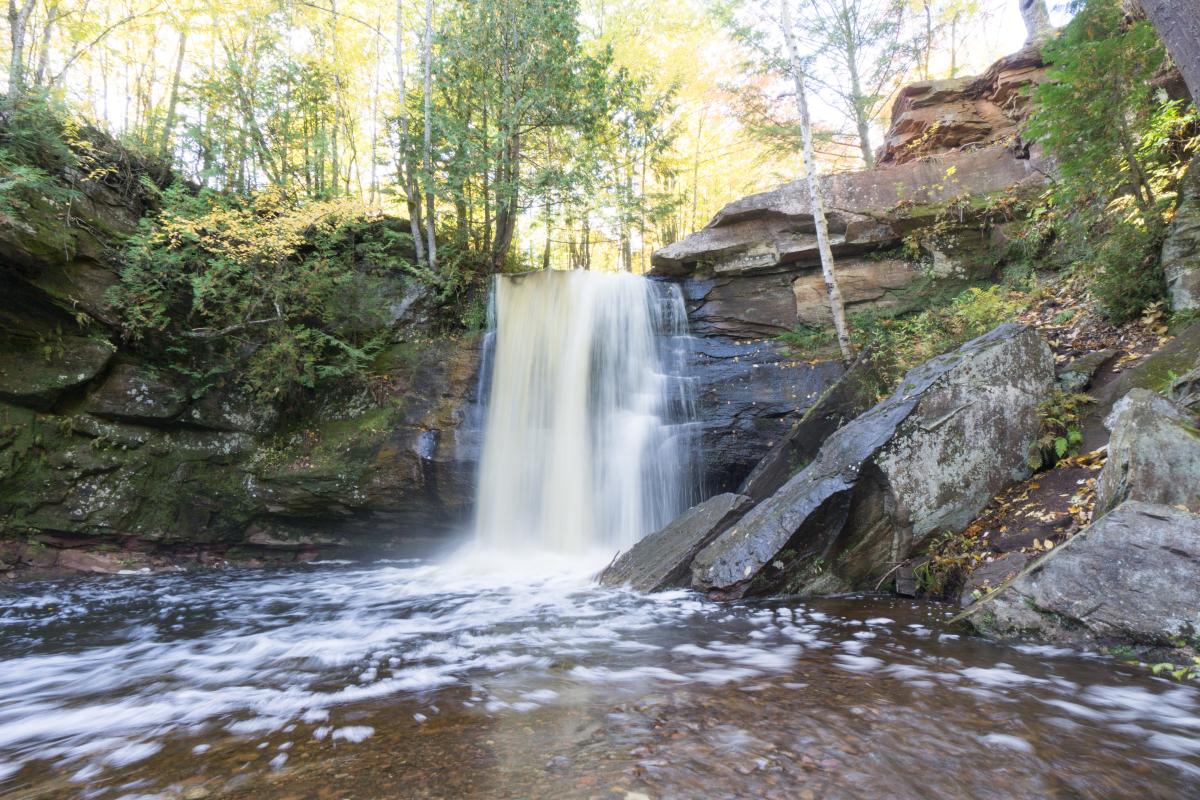Hungarian Falls is a staple of the Keweenaw adventure circuit. It’s one of the easiest to access waterfalls in the Copper Country and combines history with nature at every turn. Plus, with three unique waterfalls on the hike, you’re getting a major bang for your sight-seeing buck!
There’s a lot to see and learn about at Hungarian Falls. Best of all, this entire trip can be done in about 1.5 hours, making it an excellent afternoon adventure. Consider this your ultimate guide to one of our favorite places in the Keweenaw!
Getting There
First things first: let’s get you there. Hungarian Falls is located just above the community of Tamarack City, partway between Dollar Bay and Lake Linden. Take M-26 to Tamarack City and turn west onto 6th St. opposite the hulking remnants of the Ahmeek Stamp Mill. About a block into 6th St. make a slight left turn up the hill onto Golf Course Road. Follow the road straight up the hill for 0.5 miles until you see a rough road heading off to the left. Park along the side of Golf Course Road and head in.
If coming from the north, you can access Golf Course Road directly from US-41 just south of Calumet. From there it’s 3.4 miles until you reach the same access road. Be aware that there are more turns on this side that could confuse you.
The Hike
The hike to Hungarian Falls is fairly mild and should not be a problem for anyone with moderate hiking abilities. It can become more difficult depending on how much scrambling you want to do, with great rewards for those willing to go the extra distance. Don’t feel like the extra effort is required though, because almost everything is readily accessible from the main paths!
Upper Falls
From Golf Course Road, take the rough road into the forest. Washouts over the years have made this area quite bumpy in places. Follow the road until you hit a T-intersection. Time to make a choice! Head to the upper falls and dam first, or to the more scenic lower drops? I usually prefer to head upstream first.
Take a right at the intersection and almost immediately take a slight left onto a narrow pathway heading towards Dover Creek ahead. This will quickly lead you to the historic dam (more on that later). The spillway doesn’t count as a waterfall, so don’t be fooled into thinking you’ve seen the upper falls yet. Head up the hill and check out the small reservoir, then follow the trail up along the edge of the gorge. There are plenty of big roots along the trail in this area so watch your step.
Eventually you’ll reach an option to take a route to the top of the falls or the bottom. The top route is easier, while the bottom offers the best views of the upper falls. Your pick! The scramble down to the creek can be steep so be careful. The tight gorge walls at the bottom perfectly frame the rugged upper falls as it crashes over the precipice onto the boulders below. It’s equally scenic from above and worth viewing from both angles.
Upper Falls
Middle and Lower Falls
To reach the middle and lower falls, retrace your steps to the T-intersection from before. Head downstream on the well-worn path that parallels the creek. After a few hundred yards, you’ll quickly reach the middle falls. The middle Hungarian Falls are a sight to behold and one of the most scenic waterfalls in the entire U.P.! The river drops straight off a sandstone ledge into a pool below and should not be missed. For the best views you’ll need to see it from below. A challenging rocky path can be found just past the falls, or you can continue to the lower falls and work your way back upstream along informal footpaths (this requires crossing the creek).

Middle Falls
Just downstream from the middle falls is the final stop on your tour. Follow the path downhill a short distance until the valley opens up before you. It’s hard to describe just how immense the view is, so we’ll let the photos do the talking!
The lower Hungarian Falls crash into the depths below and are barely visible from the top. Be extremely careful near this cliff! Most people are satisfied with the huge views towards Torch Lake and the roar of the river as it rushes over the edge. Even this seasoned adventurer passes on trying to get a closer view of it.
Once you’ve gotten your fill of the scenery, backtrack up the hill and take the access road back to your vehicle. Now you’ve seen it all!

Lower falls
Hungarian Falls History
Like much of the Keweenaw, this area was heavily utilized during the copper mining era. Unlike in many areas where rivers were dammed for use in steam boilers, the small reservoir at the top of the gorge was used for fire suppression purposes. To put out potentially catastrophic blazes at the turn of the 20th century, companies like Calumet & Hecla traded one risk for another: in the event of a fire, they’d throw open a valve and unleash the reservoir’s waters on their mill below! Recovering from a literal flood was a better alternative than letting it burn to the ground.
After the mines and mills closed, the reservoir was used to supply water to the community’s fire hydrant network. Eventually this became redundant, and the reservoir was no longer needed. In late 2012, the uppermost falls and dam were put up for sale. Alarmed at the prospect of losing a popular natural attraction, local citizens worked with the Keweenaw Land Trust to purchase 10 acres of land to protect the upper parts of the gorge. I had just started working at KLT at the time and was tasked with helping to fundraise for this important project. The response was incredible, with hundreds of people donating to protect this special place. Nice work everyone!
The bulk of the gorge is owned by the Michigan Department of Natural Resources. All of these waterfalls are open to the public free of charge and will hopefully stay that way forever.
 A view from the top of the Lower Falls looking down toward Torch Lake
A view from the top of the Lower Falls looking down toward Torch Lake
Interested in updates, travel tips and quirky information about the Keweenaw? Just sign up for the Keweenaw Explorer, our monthly e-newsletter. Complete the form…
Geology
Hungarian Falls is one of the best places to see the Keweenaw Fault, a billion-year-old geological feature that shaped our landscape and history. Hundreds of millions of years of bending and pulling turned vast lava flows on their side, the results of which form many of our scenic bluffs. To the south of the demarcating line lay thick layers of sandstone, while to the north you’re more likely to find basalts and conglomerates. Usually, this narrow zone is buried under our forests and lakes, but in a few spots it comes right to the surface.
The upper Hungarian Falls is right on that defining line! Notice during your visit how the upper falls crash over hard, black rocks. These basalts are highly resistant to erosion, meaning this waterfall isn’t going anywhere anytime soon. Just downstream, the middle and lower falls flow over layers of brittle red sandstone. Eventually the lower falls will erode their way to the hard basalt layer, creating one mega waterfall similar in size to Douglass-Houghton Falls just to the north near Lake Linden. That won’t be for another few hundred thousand years or longer, so don’t stay up waiting.
Bonus Sights
The waterfalls along Dover Creek are the main attraction here and what most people check out. There’s more to this area to discover though, and you don’t even have to leave the beaten path! The opposite side of the valley is equally scenic and can be accessed most easily from the top of the hill. Cross over the creek above the upper falls and follow the trail along the other side of the reservoir. Another dam spillway can be found over here, complete with a stop log holding back water decades after it was placed.
Keep heading downstream along this path until you reach the middle falls. There’s a viewpoint just above the falls, giving you a different angle on this familiar place. Throughout the area you can find old trenches, pipes, and other evidence of the mining era, all slowly being obscured by the forest. Keep a sharp eye out, it’s everywhere!
A little ways downstream the path meets back up at the lower falls. You must cross the creek to complete the shorter loop, but this should be avoided if the water is high. Alternatively, you can keep following the footpaths on the ‘far’ side of the valley all the way down the hill! The forest is beautiful over here and the trails much quieter. You can then cross over a massive restored trestle at the bottom before returning uphill on the other side. Buyer beware: there's a lot of elevation change on this bonus loop that will add substantial time to your adventure.
Things to Know
Although this special place is open to the public, please be respectful of other visitors and practice Leave No Trace. Fires, camping, and littering are forbidden. Pack out all of your trash and help keep this area beautiful! Water, snacks, and a bag for any extra layers would be helpful. A camera is a must. There’s usually decent cell service up here, although it may cut out if you go too deep in the lower parts of the gorge.
Note: in winter Golf Course Road is not plowed along the steepest stretches of the road. It is easier to approach the falls from the upper side, adding roughly 0.3 miles on either end of your snowshoeing adventure.



